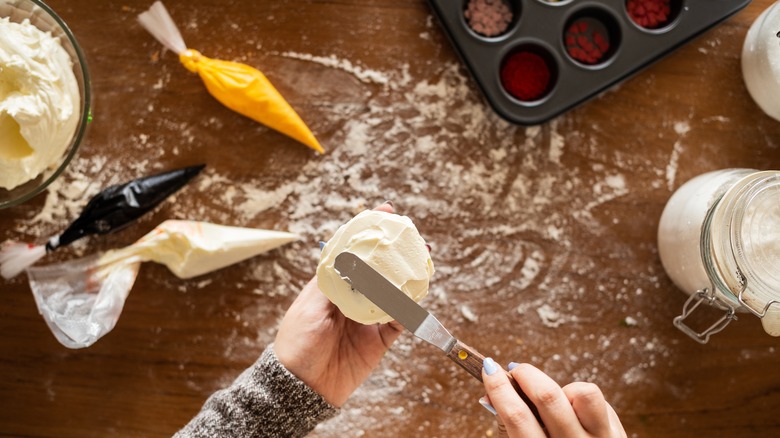Is There Even A Difference Between Cake Icing And Frosting?
Icing. Frosting. Glaze. Those terms get swirled round and round like the curlicue decorations on a cake, merging and blending until they appear to be exactly the same thing. However, although all of them are used to cover cakes, cookies, and other pastries, they're definitely different from one another and usually serve different purposes.
Frosting is the heavy-duty workhorse of the bunch. It's thick and creamy — the kind of stuff that entices you to dig your finger into its midst and take a big taste of the resulting dollop that emerges on said fingertip. Its thickness typically comes from some sort of fatty substance, like butter or cream cheese. Aside from that, it's also made from confectioners' sugar, a bit of liquid (usually milk), and some kind of flavoring, like vanilla extract or orange zest.
On the other hand, icing is thinner and more runny than frosting. Recipes for icing don't call for the same amount of fat that frosting recipes do. Usually, the pastry chef makes it out of only powdered sugar and a liquid. Milk, fruit juice, and even egg whites are all candidates for liquids when you're whipping up a batch of icing.
And finally, there's glaze, which fits into a subcategory under the icing umbrella. It's often the vanilla flavored topping that makes your cinnamon rolls taste so yummy, though vanilla flavoring isn't necessarily a requirement for it. It appears on loaf cakes and one-layer cakes, simple sweets that need only the barest of accompaniments. Of the many types of sweet cake coverings, glazes are the thinnest of the icing types.
A look at the many frosting recipes
Fortunately for frosting lovers, there isn't a dearth of 'em. From the frosting thickened with whipped butter to those made of tangy cream cheese, there's probably a frosting type for every taste. As far as the buttercream frostings go, the common denominator in all of them is the butter.
Of the different iterations, American buttercream counts among the simplest to make. Unlike some buttercream recipes, which feature either eggs or meringue, American buttercream highlights how versatile and delicious plain butter is in frosting. Like all toppings in this category, it also calls for confectioners' sugar and liquid — usually heavy cream but sometimes sweetened condensed milk.
With the other buttercream types, like Swiss, French, German, and Italian buttercreams, the variations between them plays a big role in how a pastry chef might use them to good effect on their cakes and cupcakes. For example, German buttercream will leave a velvety richness on the tongue, thanks to an addition of egg yolk custard. It makes a good option if you'd like your frostings to take on a custard-like consistency. On the other hand, Italian buttercream is your go-to recipe when you're looking for frosting that holds up to the rigors of piping, as the whipped meringue helps work as a stabilizer.
Using a creamy cheese in your frosting offers a couple of advantages. One of the best of these advantages is that frostings with a creamy cheese at the center of their recipes bring a tanginess to the cake that makes the flavor more interesting. These frostings, which tend to be made of cream cheese or mascarpone, really shine when you pair them with a carrot or spice cake.
Different types of icing recipes
As for the icing and sweet glaze recipes of the world, it's just a matter of combining a particular liquid with powdered sugar to create a runny topping. The amount of liquid called for in a recipe determines whether your topping will be a thick, opaque icing or a translucent glaze. The benefit of using an icing recipe — besides its minimalist ingredient list — is that you can easily adjust the consistency of it by either adding more powdered sugar or more liquid. As for what liquid you can use, liqueur, fruit juice, dairy, soda, and even water is all fair game. Just be sure to add a dash of extract if going for one of the plainer options.
The only outlier, as far as ingredient lists are concerned, is royal icing. This is regular icing that has a meringue powder or egg whites added to it. Those two ingredients stiffen and set the icing into a hard layer, making it a perfect ingredient when you want to add raised decorative elements, or you need something to "glue" the walls of your gingerbread house together. It once was used to help preserve and decorate royal wedding cakes (hence the name), but today it's more commonly used on delicately decorated sugar cookies.
Otherwise, icing and glazes are simple. In the end, you should turn to them when you're trying to dress up a simple recipe but not cover it in a thick, elaborate facade. The runny nature of icing means it can only be drizzled or poured on, limiting your decorating options. Instead, try using it to adorn a coffee cake or one-layer olive oil cake.


